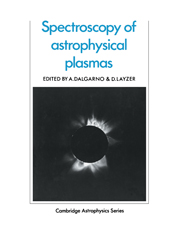Book contents
- Frontmatter
- Contents
- List of contributors
- List of abbreviations
- Preface
- 1 Optical observations of nebulae
- 2 Radio observations of HII regions
- 3 Quasars, Seyfert galaxies and active galactic nuclei
- 4 Chemical abundances
- 5 The solar chromosphere
- 6 Spectroscopy of the solar corona
- 7 Spectroscopy of circumstellar shells
- 8 The gaseous galactic halo
- 9 Astrophysical shocks in diffuse gas
- 10 Coronal interstellar gas and supernova remnants
- 11 Diffuse interstellar clouds
- 12 Laboratory astrophysics: atomic spectroscopy
- Index
3 - Quasars, Seyfert galaxies and active galactic nuclei
Published online by Cambridge University Press: 30 December 2009
- Frontmatter
- Contents
- List of contributors
- List of abbreviations
- Preface
- 1 Optical observations of nebulae
- 2 Radio observations of HII regions
- 3 Quasars, Seyfert galaxies and active galactic nuclei
- 4 Chemical abundances
- 5 The solar chromosphere
- 6 Spectroscopy of the solar corona
- 7 Spectroscopy of circumstellar shells
- 8 The gaseous galactic halo
- 9 Astrophysical shocks in diffuse gas
- 10 Coronal interstellar gas and supernova remnants
- 11 Diffuse interstellar clouds
- 12 Laboratory astrophysics: atomic spectroscopy
- Index
Summary
Introduction
Quasistellar radio sources were first recognized as objects at very large distances in 1963, when Schmidt identified several nebular emission lines in the spectrum of the stellar appearing, thirteenth magnitude object 3C273, and measured its redshift as z = 0.158. Greenstein and Matthews soon identified similar lines in 3C 48, with V = 16.2, giving z = 0.367. It was immediately clear that these highly luminous objects are beacons that can be observed out to the distant reaches of the universe. For many years OQ 172, with z = 3.53 and V= 17.8, was the most distant object known, until in 1982 an even larger redshift, z = 3.78, was measured for PKS 2000-330, a quasar with red magnitude 17.3. However, observations also quickly showed that all quasars and QSOs do not have the same absolute magnitude; like stars, they are spread over an enormous range in luminosity. Hence we can only hope that ‘understanding’ quasars, through the study of their spectra, will mean not only understanding the strongest energy sources we know in the universe, but also recognizing their absolute magnitudes from their spectra and thus determining their distances.
Long before the first quasars were discovered, galaxies with generally similar emission-line spectra were known. In 1908, Fath, working with a small slitless spectrograph on the Crossley reflector of Lick Observatory, recognized five nebular emission lines (in addition to weak Hβ) in the spectrum of NGC 1068, lines we now know as [O II] λ3727, [Ne III] λ3869, and [O III] λλ4363, 4959, 5007.
- Type
- Chapter
- Information
- Spectroscopy of Astrophysical Plasmas , pp. 59 - 88Publisher: Cambridge University PressPrint publication year: 1987
- 5
- Cited by

